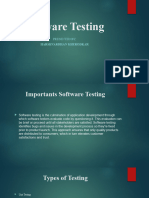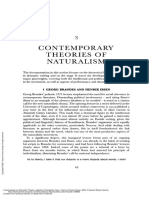0 ratings0% found this document useful (0 votes)
10 viewsDOC-20241017-WA0010.
DOC-20241017-WA0010.
Uploaded by
dhanushsrivatsav1Copyright:
© All Rights Reserved
Available Formats
Download as PDF, TXT or read online from Scribd
DOC-20241017-WA0010.
DOC-20241017-WA0010.
Uploaded by
dhanushsrivatsav10 ratings0% found this document useful (0 votes)
10 views15 pagesCopyright
© © All Rights Reserved
Available Formats
PDF, TXT or read online from Scribd
Share this document
Did you find this document useful?
Is this content inappropriate?
Copyright:
© All Rights Reserved
Available Formats
Download as PDF, TXT or read online from Scribd
Download as pdf or txt
0 ratings0% found this document useful (0 votes)
10 views15 pagesDOC-20241017-WA0010.
DOC-20241017-WA0010.
Uploaded by
dhanushsrivatsav1Copyright:
© All Rights Reserved
Available Formats
Download as PDF, TXT or read online from Scribd
Download as pdf or txt
You are on page 1of 15
Unit - 3
Levels of Software Testing
To assure and maintain the quality of software and to represent the ultimate review
of specification, design, and coding, Software testing is required. There are different
levels of testing
• Unit Testing: In this type of testing, errors are detected individually from every
component or unit by individually testing the components or units of software to
ensure that they are fit for use by the developers. It is the smallest testable part of
the software.
• Integration Testing: In this testing, two or more modules which are unit tested are
integrated to test i.e., technique interacting components, and are then verified if
these integrated modules work as per the expectation or not, and interface errors
are also detected.
• System Testing: In system testing, complete and integrated Softwares are tested
i.e., all the system elements forming the system are tested as a whole to meet the
requirements of the system.
• Acceptance Testing: This is a kind of testing conducted to ensure that the
requirements of the users are fulfilled before its delivery and that the software
works correctly in the user’s working environment.
Unit Testing
Unit Testing is a fundamental aspect of software testing where individual components
or functions of a software application are tested in isolation.
This method ensures that each unit of the software performs as expected. By focusing
on small, manageable parts of the application, unit testing helps identify and fix bugs
early in the development process, significantly improving code quality and reliability.
• Objective of Unit Testing
• The objective of Unit Testing are follows
• To isolate a section of code.
• To verify the correctness of the code.
• To test every function and procedure.
• To fix bugs early in the development cycle and to save costs.
• To help the developers understand the code base and enable them to make changes
quickly.
• To help with code reuse.
Types of Unit Testing
There are 2 types of Unit Testing:
• Manual Testing
• Automation Testing
Manual unit testing
• Manual testing is like checking each part of a project by hand, without using any
special tools. People, like developers, do each step of the testing themselves. But
manual unit testing isn’t used much because there are better ways to do it and it
has some problems:
• It costs more because workers have to be paid for the time they spend testing,
especially if they’re not permanent staff.
• It takes a lot of time because tests have to be done every time the code changes.
• It is hard to find and fix problems because it is tricky to test each part separately.
• Developers often do manual testing themselves to see if their code works
correctly.
Types of Unit Testing
Automated unit testing
• Automated unit testing is a way of checking if software works correctly without needing
lots of human effort. We use special tools made by people to run these tests
automatically. These are part of the process of building the software. Here’s how it works:
• Developers write a small piece of code to test a function in the software. This code is like a
little experiment to see if everything works as it should.
• Before the software is finished and sent out to users, these test codes are taken out.
They’re only there to make sure everything is working properly during development.
• Automated testing can help us check each part of the software on its own. This helps us
find out if one part depends too much on another. It’s like putting each piece of a puzzle
under a magnifying glass to see if they fit together just right.
• We usually use special tools or frameworks to do this testing automatically. These tools
can tell us if any of our code doesn’t pass the tests we set up.
• The tests we write should be really small and focus on one specific thing at a time. They
should also run on the computer’s memory and not need internet connection.
Workflow of Unit Testing
Unit Testing Techniques
• There are 3 types of Unit Testing Techniques. They are follows
• Black Box Testing: This testing technique is used in covering the unit tests
for input, user interface, and output parts.
• White Box Testing: This technique is used in testing the functional behavior
of the system by giving the input and checking the functionality output
including the internal design structure and code of the modules.
• Gray Box Testing: This technique is used in executing the relevant test
cases, test methods, and test functions, and analyzing the code
performance for the modules.
Integration Testing
• Integration testing is the process of testing the interface between two software
units or modules.
• It focuses on determining the correctness of the interface.
• The purpose of integration testing is to expose faults in the interaction between
integrated units.
• Once all the modules have been unit-tested, integration testing is performed.
Integration Testing
Big-Bang Integration Testing
• It is the simplest integration testing approach,
where all the modules are combined and the
functionality is verified after the completion of
individual module testing.
• Big-bang integration testing is a software testing
approach in which all components or modules
of a software application are combined and
tested at once.
• This approach is typically used when the
software components have a low degree of
interdependence or when there are constraints
in the development environment that prevent
testing individual components.
Integration Testing
Bottom-Up Integration Testing
• In bottom-up testing, each module at lower
levels are tested with higher modules until
all modules are tested.
• The primary purpose of this integration
testing is that each subsystem tests the
interfaces among various modules making
up the subsystem.
• This integration testing uses test drivers to
drive and pass appropriate data to the
lower-level modules.
Integration Testing
Top-Down Integration Testing
• Top-down integration testing technique is
used in order to simulate the behaviour of
the lower-level modules that are not yet
integrated.
• In this integration testing, testing takes
place from top to bottom.
• First, high-level modules are tested and then
low-level modules and finally integrating the
low-level modules to a high level to ensure
the system is working as intended.
Integration Testing
Mixed Integration Testing
• A mixed integration testing is also called
sandwiched integration testing.
• A mixed integration testing follows a
combination of top down and bottom-up testing
approaches.
• In top-down approach, testing can start only
after the top-level module have been coded and
unit tested.
• In bottom-up approach, testing can start only
after the bottom level modules are ready.
• This sandwich or mixed approach overcomes this
shortcoming of the top-down and bottom-up
approaches.
• It is also called the hybrid integration testing.
also, stubs and drivers are used in mixed
integration testing.
System Testing
• System testing is a type of software testing that evaluates the overall functionality
and performance of a complete and fully integrated software solution.
• It tests if the system meets the specified requirements and if it is suitable for
delivery to the end-users.
• This type of testing is performed after the integration testing and before the
acceptance testing.
System Testing Process
Types of System Testing
• Performance Testing: Performance Testing is a type of software
testing that is carried out to test the speed, scalability, stability and
reliability of the software product or application.
• Load Testing: Load Testing is a type of software Testing which is
carried out to determine the behavior of a system or software
product under extreme load.
• Stress Testing: Stress Testing is a type of software testing performed
to check the robustness of the system under the varying loads.
• Scalability Testing: Scalability Testing is a type of software testing
which is carried out to check the performance of a software
application or system in terms of its capability to scale up or scale
down the number of user request load.
Acceptance Testing
It is formal testing according to user needs, requirements, and business
processes conducted to determine whether a system satisfies the acceptance
criteria or not and to enable the users, customers, or other authorized
entities to determine whether to accept the system or not.
Types of Acceptance Testing
• User Acceptance Testing (UAT)
• Business Acceptance Testing (BAT)
• Contract Acceptance Testing (CAT)
• Regulations Acceptance Testing (RAT)
• Operational Acceptance Testing (OAT)
• Alpha Testing
• Beta Testing
You might also like
- Answers Correct Answer User AnswerDocument3 pagesAnswers Correct Answer User AnswerAhmed Mansour Sereer83% (6)
- Automated Software Testing Interview Questions You'll Most Likely Be AskedFrom EverandAutomated Software Testing Interview Questions You'll Most Likely Be AskedNo ratings yet
- ISTQB Certified Tester Foundation Level Practice Exam QuestionsFrom EverandISTQB Certified Tester Foundation Level Practice Exam QuestionsRating: 5 out of 5 stars5/5 (1)
- Lecture 3.3.5 Test StrategiesDocument23 pagesLecture 3.3.5 Test StrategiesSahil GoyalNo ratings yet
- SE - UNIT3 Part1Document47 pagesSE - UNIT3 Part1Prathamesh KulkarniNo ratings yet
- Software Testing Chapter-3Document14 pagesSoftware Testing Chapter-3shyamkava01No ratings yet
- Level_of_Testing_slides_eMvO54ziWHDocument14 pagesLevel_of_Testing_slides_eMvO54ziWHjovialdarwin8No ratings yet
- APznzaZa8s6ndtFk8nqs50q schpJy0apZO8FoG 9JtGxuywMO3NebdZBJmnnZGpJblybwf4So9MTutTQa-cwvPHnB1Otg9XwJ1OtsNDocument22 pagesAPznzaZa8s6ndtFk8nqs50q schpJy0apZO8FoG 9JtGxuywMO3NebdZBJmnnZGpJblybwf4So9MTutTQa-cwvPHnB1Otg9XwJ1OtsNANYTHING PREETESH WANTSNo ratings yet
- Software TestingDocument14 pagesSoftware Testingaiswaryaep07No ratings yet
- LECT10_DebuggingDocument22 pagesLECT10_Debuggingkush4409No ratings yet
- Se 8Document25 pagesSe 8Abbas RiazNo ratings yet
- Software Engineering Unit4Document50 pagesSoftware Engineering Unit4hrithik04350No ratings yet
- Unit 6 SW TestingDocument49 pagesUnit 6 SW TestingPrasad Patil100% (1)
- ISE Slide 8Document7 pagesISE Slide 8Amna MushtaqNo ratings yet
- CH - 4 Test Levels and Testing TypesDocument50 pagesCH - 4 Test Levels and Testing TypesUmesh MahajanNo ratings yet
- Ch5-2 Software TestingDocument31 pagesCh5-2 Software Testingabdulbaset alselwiNo ratings yet
- Week02 Lecture06Document20 pagesWeek02 Lecture06Niloy DevNo ratings yet
- 5 THDocument32 pages5 THpvkaleNo ratings yet
- Chapter 3 Levels of Testing TY BcsDocument31 pagesChapter 3 Levels of Testing TY BcsP NNo ratings yet
- Software TestingDocument29 pagesSoftware TestingnandiniNo ratings yet
- UNIT 5 Software Testing 1Document35 pagesUNIT 5 Software Testing 1ijantkartanishkaNo ratings yet
- UNIT-5 Software TestingDocument32 pagesUNIT-5 Software TestingsamikshapshettiNo ratings yet
- SE 5 3 Testing Conven SoftwDocument13 pagesSE 5 3 Testing Conven Softwnishan AlipkNo ratings yet
- Unit 1 STADocument54 pagesUnit 1 STApraveen04.cseNo ratings yet
- TestingDocument18 pagesTestingmatthewhoulihan87No ratings yet
- Software Testing: H.P.Shehan IsharakaDocument6 pagesSoftware Testing: H.P.Shehan IsharakaShehan IsharakaNo ratings yet
- Module 3-software TestingDocument110 pagesModule 3-software TestingVaishak ShettyNo ratings yet
- Software Testing StrategiesDocument25 pagesSoftware Testing Strategieshabado badoNo ratings yet
- BCA Project Part - 14Document125 pagesBCA Project Part - 14bhagyashri.kalolaNo ratings yet
- SE unit-4Document33 pagesSE unit-422wj1a05ahNo ratings yet
- Testing Levels(G3)Document43 pagesTesting Levels(G3)jecid34No ratings yet
- Basic Iphone Application DevelopmentBlock-5Document35 pagesBasic Iphone Application DevelopmentBlock-5solanki.hemaxi21No ratings yet
- Chapter 7 Software TestDocument11 pagesChapter 7 Software TestHassan Bashir (Oday)No ratings yet
- Seminer Ch8 Software TestingDocument37 pagesSeminer Ch8 Software Testingchassan.kalel.1984No ratings yet
- UNIT IVDocument34 pagesUNIT IVtarun singhNo ratings yet
- Ms TestingDocument62 pagesMs Testingmansha99No ratings yet
- Software TestingDocument33 pagesSoftware TestinglollolNo ratings yet
- BCA Project Part - 12Document126 pagesBCA Project Part - 12bhagyashri.kalolaNo ratings yet
- 1.software TestingDocument40 pages1.software TestingarunlaldsNo ratings yet
- Chapter-5 Levels of TestingDocument16 pagesChapter-5 Levels of Testingcelestiastorm22No ratings yet
- Chapter 8 RevisionDocument15 pagesChapter 8 Revisionmidomostafa504No ratings yet
- Software Testing Fundamentals - Pragati DemannaDocument38 pagesSoftware Testing Fundamentals - Pragati DemannaAsif RanaNo ratings yet
- Unit-7: Types of TestingDocument9 pagesUnit-7: Types of Testingchandp2No ratings yet
- 4940system TestingDocument16 pages4940system TestingdsouzaunknowndevilroyNo ratings yet
- CH 2Document84 pagesCH 2gauravdhangar101No ratings yet
- testingDocument19 pagestestingSunitha RekhaNo ratings yet
- SQT_Unit-1Document8 pagesSQT_Unit-1KaviyaNo ratings yet
- SE FileDocument12 pagesSE Fileares4006115No ratings yet
- Software Quality and Testing (CSC 4133) : Common Interview QuestionsDocument46 pagesSoftware Quality and Testing (CSC 4133) : Common Interview QuestionsrohanNo ratings yet
- Unit-4 SEngineeringDocument11 pagesUnit-4 SEngineeringtanveerpal2002No ratings yet
- SoftwareTesting PresentationDocument16 pagesSoftwareTesting PresentationPraveen BhivsaneNo ratings yet
- SE Unit-04Document6 pagesSE Unit-04pish2922No ratings yet
- Level of TestingDocument7 pagesLevel of Testingkulwantchahar123No ratings yet
- Software TestingDocument39 pagesSoftware TestingTanzeel SialNo ratings yet
- Software TestingDocument18 pagesSoftware TestingHarshvardhan KherodkarNo ratings yet
- CH 2Document81 pagesCH 2ojjas2005No ratings yet
- Lec 4Document51 pagesLec 4ahksase2312No ratings yet
- IntegrationDocument12 pagesIntegrationYogendra RajavatNo ratings yet
- Chapter 9 Testing StrategiesDocument44 pagesChapter 9 Testing StrategiesBhumireddy ChandanaNo ratings yet
- BCA Project Part - 13Document125 pagesBCA Project Part - 13bhagyashri.kalolaNo ratings yet
- DOC-20241017-WA0008.Document14 pagesDOC-20241017-WA0008.dhanushsrivatsav1No ratings yet
- DOC-20241113-WA0007. (1)Document21 pagesDOC-20241113-WA0007. (1)dhanushsrivatsav1No ratings yet
- DOC-20241017-WA0009. (1)Document40 pagesDOC-20241017-WA0009. (1)dhanushsrivatsav1No ratings yet
- DOC-20241111-WA0004.Document16 pagesDOC-20241111-WA0004.dhanushsrivatsav1No ratings yet
- Aero Engine Services: Pt. Nusantara Turbin Dan PropulsiDocument17 pagesAero Engine Services: Pt. Nusantara Turbin Dan PropulsiMeingkarNo ratings yet
- The Conceptual Framework and HypothesisDocument2 pagesThe Conceptual Framework and HypothesisKylie JennerNo ratings yet
- Example of Writing Term PaperDocument5 pagesExample of Writing Term Paperc5pgpgqk100% (1)
- Excel 4.0 Macro Functions Reference PDFDocument653 pagesExcel 4.0 Macro Functions Reference PDFSatyendra SinghNo ratings yet
- Florin Olariu: "Alexandru Ioan Cuza", University of Iași Department of Computer ScienceDocument78 pagesFlorin Olariu: "Alexandru Ioan Cuza", University of Iași Department of Computer ScienceGigi FloricaNo ratings yet
- Morphosyntax License L3 S6Document108 pagesMorphosyntax License L3 S6constantkone1999No ratings yet
- Life Cycle Phases: Unit - IiiDocument20 pagesLife Cycle Phases: Unit - IiijarvisNo ratings yet
- WWW - Manaresults.co - In: Engineering Mathematics-I Part-ADocument3 pagesWWW - Manaresults.co - In: Engineering Mathematics-I Part-AkpanchamgamNo ratings yet
- A Sourcebook On Naturalist Theatre - (1 Georg Brandes and Henrik Ibsen)Document3 pagesA Sourcebook On Naturalist Theatre - (1 Georg Brandes and Henrik Ibsen)Holly FongNo ratings yet
- Sentence Relations and ThruthDocument22 pagesSentence Relations and ThruthOlga DabŠtrb100% (1)
- The Radif of Persian Classical Music Studies of Structure and Cultural Context by Bruno NettlDocument258 pagesThe Radif of Persian Classical Music Studies of Structure and Cultural Context by Bruno NettlMarco AlleviNo ratings yet
- Activity 2Document2 pagesActivity 2Daryl SeraficaNo ratings yet
- Aerosmith I Don't Want To Miss A Thing Letra Ing Esp PDFDocument2 pagesAerosmith I Don't Want To Miss A Thing Letra Ing Esp PDFKevin Job NinaNo ratings yet
- Case Study On Automatic Transformation of User Stories Into UMLDocument6 pagesCase Study On Automatic Transformation of User Stories Into UMLChandresh PrasadNo ratings yet
- TCS Previous Year Interview QSNDocument4 pagesTCS Previous Year Interview QSNdeekshaverma2505No ratings yet
- Reading C1 How Humans Evolved LanguageDocument3 pagesReading C1 How Humans Evolved LanguageMaria Jose Martínez RoldánNo ratings yet
- Software Proj InvoiceDocument34 pagesSoftware Proj InvoiceParvaiz RainaNo ratings yet
- Krishna Reddy ABAPDocument4 pagesKrishna Reddy ABAPkrishna reddy100% (1)
- Tohak Kevin Digital ProductDocument6 pagesTohak Kevin Digital Productapi-405574504No ratings yet
- MASTER TEACHERS RPMS PURPLE TEMPLATE - Results-Based-Performance-Management-SystemDocument46 pagesMASTER TEACHERS RPMS PURPLE TEMPLATE - Results-Based-Performance-Management-Systemangeline100% (2)
- ECE664 Raspberry PiDocument2 pagesECE664 Raspberry PiManish DubeyNo ratings yet
- GNS 111 Course ContentDocument1 pageGNS 111 Course Contentomololabalogun676No ratings yet
- SP Vyasa-Puja Book 2024Document367 pagesSP Vyasa-Puja Book 2024radhanathkdas.bvksNo ratings yet
- Hydro1 4Document104 pagesHydro1 4Abegail Mae PingosNo ratings yet
- BrahmsDocument5 pagesBrahmsPaul DeleuzeNo ratings yet
- Nbns3603 Reflective Thinking and Writing Assignment 2Document10 pagesNbns3603 Reflective Thinking and Writing Assignment 2dicky chongNo ratings yet
- SCD5200 Hardware User ManualDocument66 pagesSCD5200 Hardware User ManualZafer SezerNo ratings yet
- 1 - Art Appreciation (GEED 10073) - Introduction To Art AppDocument20 pages1 - Art Appreciation (GEED 10073) - Introduction To Art AppJullianne Hyacinth Exsano JovenNo ratings yet
- Assessing Speaking BrownDocument3 pagesAssessing Speaking BrownApriliaNo ratings yet





























































































